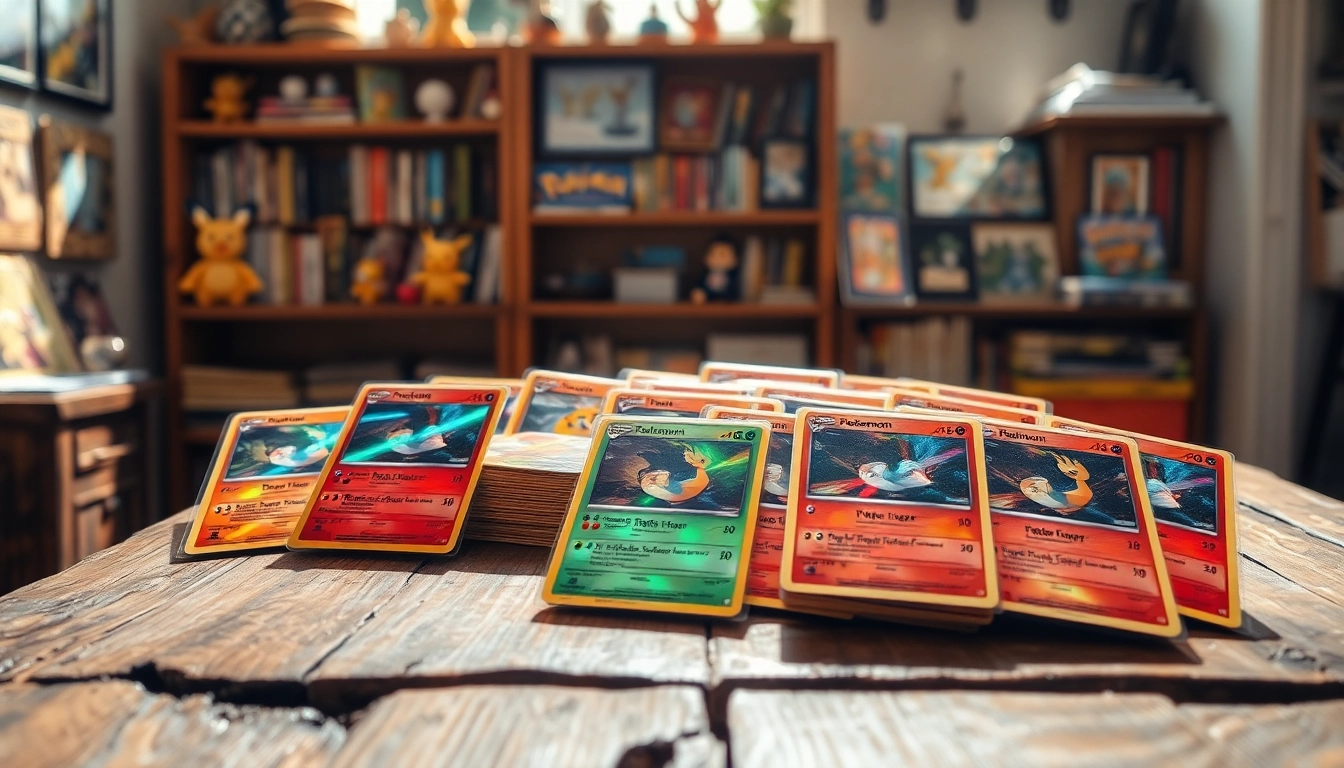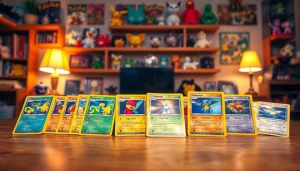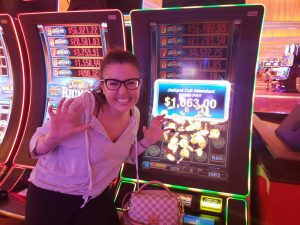Understanding Real Pokemon Cards
Collecting Pokémon cards is not just a hobby; for many, it’s a passion. However, with the rise in popularity of Pokémon trading cards, so too has the prevalence of counterfeit products. In this guide, we will explore everything you need to know about real Pokémon cards. We’ll cover how to identify genuine cards, where to purchase them, their value, how to care for your collection, and how to connect with fellow enthusiasts. Understanding real pokemon cards is essential for collectors, whether you are just starting or have an extensive collection already.
What Makes Pokemon Cards Real?
To appreciate real Pokémon cards fully, it’s essential first to understand what distinguishes them from counterfeit versions. Genuine Pokémon cards are produced by the Pokémon Company and have specific characteristics that help verify their authenticity:
- Card Material: Authentic Pokémon cards are made from high-quality cardstock with a specific thickness and texture that sets them apart from fakes.
- Print Quality: Real cards have clear and sharp images, vibrant colors, and precise borders. A blurry print or misaligned borders often indicates a counterfeit.
- Holographic Features: Many Pokémon cards feature holographic elements that reflect light. This effect is difficult to replicate accurately in fakes.
- Ruler Method: You can measure the dimensions of a Pokémon card; authentic cards are standardized at 2.5 x 3.5 inches. Cards that differ in size may be counterfeit.
- Blacklight Test: If you shine a blacklight on a genuine Pokémon card, the energy symbol will glow, while counterfeit cards will not.
Identifying Genuine Cards vs. Fakes
Knowing how to distinguish between real and fake Pokémon cards can save you time and money. Here are some methods to help identify authentic cards:
- Light Test: Hold the card up to a light source. Authentic cards will allow light to pass through somewhat, revealing a distinctive feel. Fake cards tend to be too thick and do not allow light to penetrate effectively.
- The Bend Test: Gently bend the card. Real cards will flex slightly without damage. If the card bends too easily or shows visible creases, it’s likely a fake.
- Wording and Spelling: Check for typos or misspellings, as counterfeit cards frequently have printing errors. Genuine cards are printed flawlessly.
The Importance of Authentication
For serious collectors, the authentication of Pokémon cards is critical. It not only preserves the integrity of your collection, but it also enhances the potential resale value. Many enthusiasts choose to have their cards graded by professional services like PSA (Professional Sports Authenticator) or BGS (Beckett Grading Services). Graded cards are encapsulated in protective cases and assigned a numerical grade based on their condition, which can immensely affect their market value.
Where to Buy Real Pokemon Cards
Once you understand what makes a Pokémon card genuine, the next step is knowing where to purchase them safely. There are various options for acquiring real Pokémon cards, each with their own set of pros and cons.
Top Retailers for Genuine Pokemon Cards
When looking for reliable retailers, consider well-established stores with reputations for quality products. Here are some of the top retailers you can trust for purchasing real Pokémon cards:
- Pokémon Center: The official Pokémon website offers a comprehensive selection of Pokémon trading cards, ensuring that all products are genuine. Visit their official store for exclusive items.
- GameStop: Known for video games, GameStop also stocks a selection of Pokémon cards and collectibles. Many locations have knowledgeable staff who understand the nuances of Pokémon card collecting.
- Toys “R” Us: While many stores have closed, some locations still operate and offer Pokémon cards among their toy collections. Their partnership with Pokémon ensures authenticity.
Online Marketplaces and Their Trustworthiness
Online shopping has become increasingly popular for acquiring Pokémon cards. However, not all online marketplaces guarantee authenticity. Here are some trusted platforms where you can safely purchase real Pokémon cards:
- eBay: While eBay has a vast selection of Pokémon cards, it’s vital to check seller ratings and reviews before making a purchase. Look for sellers with a history of selling authentic products.
- TCGPlayer: This website specializes in trading card games (TCGs) and has a reputation for providing high-quality Pokémon cards from verified sellers.
- Amazon: If purchasing from Amazon, ensure the seller has positive feedback and reviews. Beware of offers that seem too good to be true, as they might be selling counterfeit cards.
Local Shops vs. Online Purchases
When deciding between local shops and online purchases, each option has its own benefits:
- Local Shops: Visiting local card shops allows you to inspect cards personally, ensuring their authenticity. You can also build relationships with local enthusiasts, who may provide insight into rare card acquisitions and local events.
- Online Purchases: Online shopping provides access to a vast selection and often better prices. However, this convenience comes with the responsibility of ensuring you’re buying from reputable sources.
Evaluating the Value of Real Pokemon Cards
Understanding the value of your Pokémon cards is crucial for both collectors and investors. Several factors determine the worth of a card, and by knowing them, you can make informed decisions.
Market Trends: What Affects Card Prices?
The demand for certain cards can greatly affect their market value. Trends tend to shift based on the following:
- Popularity of Pokémon: Cards associated with popular Pokémon characters frequently see price increases. For example, cards of Pikachu or Charizard typically have high demand.
- Expansion Sets: New card sets can renew interest in older cards, driving up their prices due to nostalgia and the introduction of new game mechanics.
- Collector Demand vs. Player Demand: Cards that are popular among collectors might differ from those preferred by players in competitive games. Understanding these distinctions can aid in evaluating a card’s worth.
Assessing Card Condition and Its Impact on Value
The condition of a card can dramatically affect its resale value. The grading scale typically used ranges from Mint (highest) to Poor (lowest). Here’s how to assess card condition:
- Mint Condition: No visible flaws; the card looks as though it has just come from the pack.
- Near Mint: Card may have slight imperfections, but they are barely noticeable.
- Lightly Played: Cards in this condition show evidence of minor wear, such as slight surface scratches.
- Moderately Played: More obvious signs of wear are present, or small creases or bends may be noticeable.
- Heavily Played: Significant damage or wear is evident, impacting the card’s aesthetic and value.
Collector’s Items: Understanding Rarity
Rarity plays a substantial role in determining the value of Pokémon cards. Typically, the rarer a card, the higher its value. Here’s a breakdown of what constitutes rarity:
- Common, Uncommon, and Rare Cards: Cards are categorized based on how frequently they are found in booster packs. Rare cards often come with unique features like holographic images or special editions.
- Promo Cards: These cards are distributed in limited quantities for promotional events, making them highly sought after by collectors.
- Grade Levels: Cards graded higher are often considered more valuable, as they showcase both rarity and condition.
Caring for Your Real Pokemon Card Collection
Proper care and maintenance is essential in preserving the value of your Pokémon cards. Following best practices ensures your cards’ longevity and market value remains intact.
Storage Solutions for Preservation
Storing Pokémon cards correctly can prevent damage from environmental factors. Here are some recommended storage solutions:
- Toploaders: Rigid plastic holders that keep cards secure and protected from bends and scratches.
- Binder Sleeves: Collectors often use binders with protective sleeves, allowing easy viewing while keeping cards safe.
- Card Boxes: Specialty card boxes can provide excess protection. Look for acid-free boxes to avoid deterioration over time.
Cleaning and Maintenance Tips
Cleaning cards requires careful handling. Here are a few tips:
- Avoid using liquids or cleaners. If a card is dirty, simply use a soft, dry cloth to wipe it clean.
- Never attempt to repair bent or damaged cards, as this can devalue the card even further.
Displaying Your Collection Safely
Showcasing your Pokémon card collection is an exciting aspect of being a collector. Here are some safe ways to display:
- Framed Displays: Consider framing your highest-value cards for a wall display.
- Glass Displays: Secure display cases protect cards from dust and accidental damage while showcasing them beautifully.
Engaging with the Pokemon Card Community
Being part of the Pokémon community can enhance your collecting experience. Here’s how you can connect with like-minded enthusiasts.
Joining Local and Online Collector Groups
Communities often provide valuable insights, support, and trading opportunities:
- Social Media Groups: Platforms like Facebook and Reddit have dedicated groups where collectors share knowledge, advice, and arrange trades.
- Local Gatherings: Seek out local game stores that host events. It’s a great way to meet other collectors and share experiences.
Participating in Tournaments and Events
Tournaments and events not only offer a chance to compete but also gather with the community:
- Competitions allow players to test decks using their collection, creating a vibrant atmosphere focused on camaraderie.
- Event coverage can inform you of trending cards and market shifts, enhancing your collecting strategies.
Sharing Insights and Trading Cards
Trading cards and sharing knowledge can deepen your collecting experience. Develop relationships with other collectors, as they may provide insights into specific cards, including their rarity and market value.
In conclusion, navigating the world of real Pokémon cards can be rewarding, insightful, and fun. By understanding how to identify authentic cards, knowing where to buy them, evaluating their worth, and connecting with the community, you’ll enhance both the enjoyment and value of your collection. Happy collecting!


